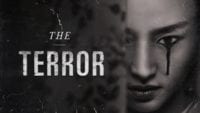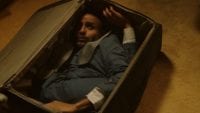
Mainlining is our new featured series where we run through all the mainline games in a series one article per game, in often different and original ways. This week, continuing thru the Castlevania series, we enter the brave new world of 16 bit graphics as Simon Belmont is back in Super Castlevania IV, the 1991 remake-quel for the Super Nintendo (pronounced Ssness).
FEELS LIKE THE FIRST TIME

I’m not a stickler for video game continuity. I understand games have to play fast and loose with plots in order to keep bringing back the same antagonist game after game. This game is considered a reboot in Japan, while in America it’s generally regarded as a remake of the original game since it features original protagonist Simon Belmont embarking on a very similar quest. However, the game is Super Castlevania IV, and four implies it’s a sequel, although it was most likely just to connect this game to the previous entries and avoid such confusion in the first place. Bottom line, it’s a Belmont vs Dracula rematch, for the first time, again.
With the NES trilogy in the rear view mirror, we move on to the next generation of Castlevania games. While the older games often excelled at being brutally difficult, they were often that way due to hardware limitations and the game designers strategic placement of live-siphoning pitfalls to extend overall playtime. But we’re now in the early days of the SNES era, and although the technology was still in it’s infancy on the 16 bit console, Super Castlevania IV never met a new trick or bit of technology it didn’t like. This isn’t a remake akin to the ones where they redress the levels and add modern graphics, this is a game designed by people who were let loose in a toy shop where they could take Simon in new and exciting directions, and they emptied the bag of tricks.
YOU DON’T HAVE MOVES LIKE BELMONT
Moving over to the SNES, the Castlevania series went through not only several cosmetic changes but also some quality of life changes. Simon still lumbers around like an 80s power walker, but now his jumps can be adjusted in midair, meaning you can do a bit of course correction on the fly when enemies spawn from the right side of the screen and make a beeline for you.
When he crouches he can move forward and backwards which I assume requires muscles I’ll never possess. He can jump up to the middle of a stairway instead of having to walk up the whole thing like some sucker. He can even jump down from a stairway, which is something you’ll do accidentally at some point, probably falling into a pit, and dying. That’s how you’ll know you’ve done it!
Even the Vampire Killer, your trusty whip, is souped up as you can now whip in 8 different directions because the SNES was all about that D pad. Even in it’s least powerful state Simon’s whip is magnificent, it goes so far away from his body. Not only that, you can just extend your arm out and let your whip hang causing enemies below to take damage (albeit minor) by just walking into it. I call this move the Whipple Hang or the Jim Dangle. Your choice. They’re both equally stupid. Some people refer to Simon dangling the end of his whip in the face of his enemies as something else, but that’s none of my business.
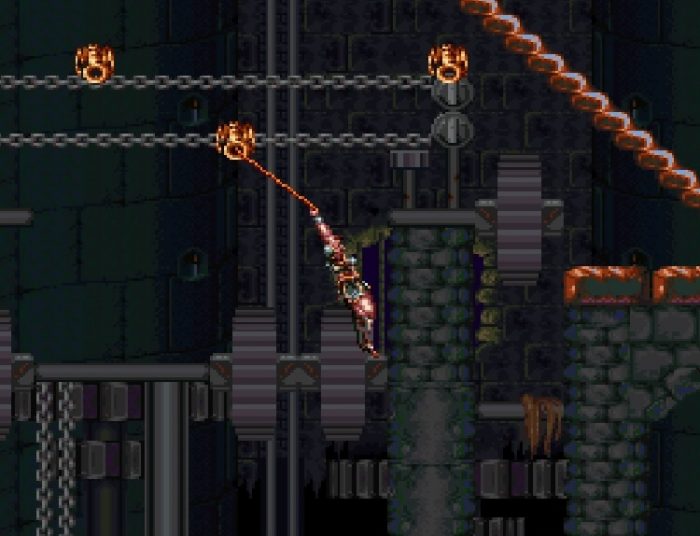
Seriously, it was a crazy time back in 1991 what with Simon grapple hooking his whip into rings and swinging across large gaps like some Gothic bionic commando.
MUSIC OF THE NIGHT
You won’t catch me gushing about music in games very often. I know little of composers outside of Koji Kondo, the genius behind The Legend of Zelda series, but the soundtrack to Super Castlevania IV is sublime. I’m neither a music critic, nor a music snob, so I have no real degree in music appreciation. Plus, I had to go to Catholic school as a kid, where they teach sinful children music must be dour and soulless. Nevertheless, I liked the music in this game, for what it’s worth.
The Theme of Simon is one of my favorite 16 bit tunes of all time, and it’s catchy as hell. All the tunes in this game are. Whether you’re swatting off frogs to the beat of Forest of Monsters or exploring the confines of a cavern to the flutes and foreboding sounds of The Cave, the music compliments the game in a way I even appreciated as a kid.
Level B1 remixes the classic Vampire Killer theme from Castlevania and Level B2 drops a new Beginning, the Level One theme in Castlevania III. Not only that, Super Castlevania IV managed to take something from Simon’s Quest and make it cool. Ladies and gentlemen, they remixed Bloody Tears and it’s so fantastic they’ve been remixing it into almost every entry since. A version of it even made it’s way into the Netflix show.
But enough talk, right? Let’s have at it.
THIS IS A STORY ABOUT CONTROL

You’ve got the moves. You’ve got the weapon. You’re ready. Cause it’s all about control, and you’ve got lots of it.
Because this was an early SNES game, the designers had that aforementioned bag of tricks and they came out of the ivy laced gates hot. Simon was now able to move between the foreground and the background. And check out the beautiful parallax scrolling, which I’d explain in greater detail, but I’m trying to keep your attention.

Needless to say, the game is filled with lovingly crafted details and little visual touches. The way the gate crashes up from the ground while the vines sprout up shortly thereafter. The way the moon passes the windows in the barn just long enough to distract you to the fact a horse head blends in with the ground waiting to surprise you.

The horse heads in the barn are creepy and oddly elusive if you don’t go straight at them right away. It’s funny to me that I always mistook the ravens in the original Castlevania as flying horse heads, and then three games later floating horse heads are an actual thing. At the time I just thought they perfected the flying horse head character design, but Mr. Hed was an original character.
Level 2’s bag of tricks includes the semi transparent mist monsters (Invisible Wraiths) that blend in with the background and frogs—real, tiny, frogs. This is where you learn that mindlessly waggling your whip around works as a clumsy but effective shield for smaller, pesky enemies like this. Plus, you don’t want to die by frog. You slump to the ground and this little frog just hops around, seemingly unaware of what they’ve done. It’s a wholly shameful way to go out.

This is also the level where we learn that Simon can now touch a body of water, or some type of liquid, and not immediately perish. He even spends the back half of the level fighting the oddly changing current of a stream.
Medusa makes her obligatory appearance here, this time downgraded to a mid-level boss, and once again our girl gets mad disrespected. She does have the power to stone you with her steely gaze, but you can dispatch her so quickly with the whip and boomerang she probably won’t get the chance to charge up her eyes, or whatever she has to do to make that happen.

THE TRANQUIL AND THE FRUSTRATING
Level 3 begins in a calm cave where enemies are few and far between. There are easy to discover secrets to be found and slow falling stalactites to calmly sidestep as you make you way towards the waterfall.
Slow moving Mud Men break down into multiple, smaller versions of themselves like inoffensive nesting dolls. Even the Bone Pillar statues are placed in easy to attack spots, and are lined up perfectly for you to whip down any projectiles they may fire out at you.

Once you get to the base of the waterfall, the game’s music takes a slightly sinister turn. The section begins with a (fairly obvious looking) collapsing bridge that you must cross. Again, the enemies aren’t all that difficult to defeat, but their placement and the environment surrounding them is decidedly more dangerous.
Dealing with those weird armadillo-looking Needle Lizard enemies isn’t bad, but when you have to also contend with those unkillable fuzz balls, all while swinging and having to make precise jumps, the whole endeavor gets downright precarious.
Castlevania games have their fair share of unfair jumps. Here in Level 3-2, at the very end of the sequence where you scale the side of the waterfall, there is a jump requiring such pinpoint accuracy that when you successfully make the jump Simon sometimes looks like he glitches a little, like when Mario almost jumps over the flagpole in OG Super Mario Bros. The jump was so tough, when I was younger I considered the possibility I had to go left at the top of the waterfall somehow, which led to different, but equally frustrating, deaths.

This is one of the reasons why I disagree with the common opinion that this game is “a little on the easy side”. I agree that it’s easier than part III, but man, most games are. Personally, I found the game to have several quality-of-life changes in the control, while also finding new and different ways to amp up the difficulty.
Level 3-3 does this by throwing weird curveballs like these random blocks that fall from the sky out of nowhere, just as the platforms below your feet being to crumble. The mix of tension and panic will potentially lead to more than a few deaths, especially with the collapsing floors preventing you from slowing your forward motion too much.

There are also several swinging jumps in this section that are second nature to me now but were difficult to gauge initially. Again, you will fall to your death and have to chalk it up to the learning process. I think when people refer to the ease of this game, they often forget there were many parts that we had to master when we played this game back in 1991, and those memories just held. If Super Castlevania IV was a lesser game, I think we would’ve forgotten when and how to do those tricky swing jumps. When a game can trigger something in your instinctual nature like that, I believe it has truly done its job.
SKELETONS, TRICKY PLATFORMS AND A WHOLE MESS OF 16 BIT TECHNOLOGY
As you begin level 4 you observe that the skulls embedded in the walls watch your every move. The creep factor is high here. Not since the skittering of the mutant silverfish in the opening title screen was I so unsettled. Of course, then they tossed in the wacky, arm bone flailing, skeleton torsos and things went back to a less dark place.
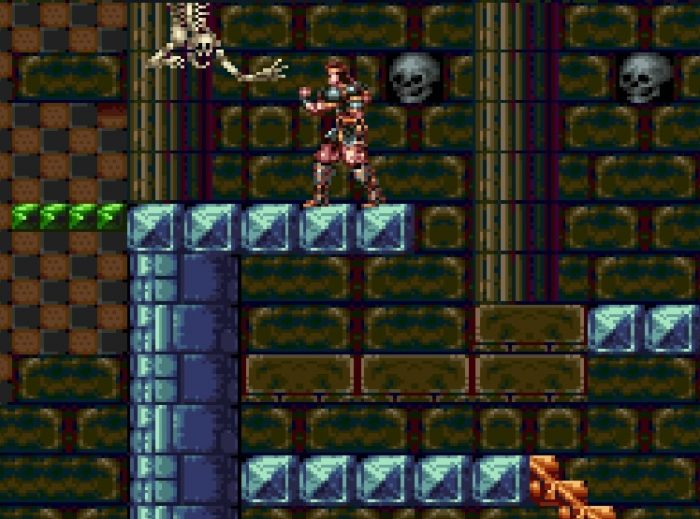
Stage 4 features the use of Mode 7 graphics which allowed the screen to seemingly rotate in many different ways. This is shown in 2D mode in a short section where you grapple and hang while the room spins around, and in another short section immediately following where you are seemingly inside a spinning drum. The level even concludes with a very blocky and pixelated battle with Mode 7 enhanced boss Koranot (Tonarok backwards).

THE THRESHOLD
Castlevania looms ahead and Level 5 is a short jaunt down the lane leading to the front door. Much like Castlevania III, you don’t begin at the titular castle and actually spend half the game making your way there. The map even changes to an interior map of Castlevania just like Dracula’s Curse did.

LADIES AND GENTLEMEN, WELCOME TO CASTLEVANIA
The main entrance to Castlevania is still as familiar looking as ever but set to organ music. No reprise of Vampire Killer here.
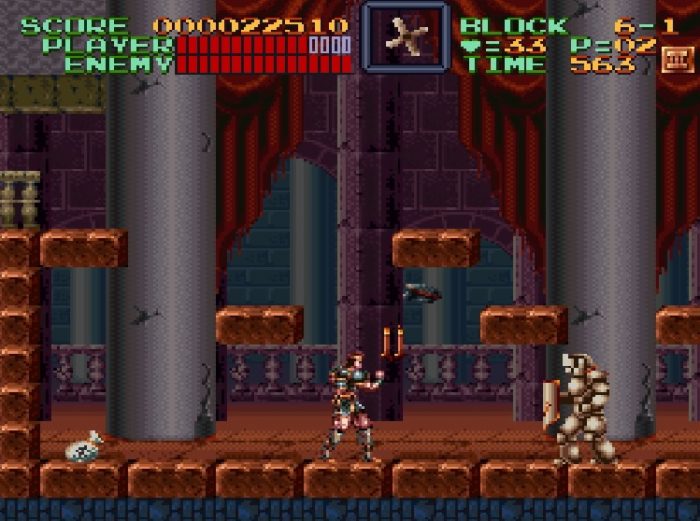
There are some very specific things I always judge from one Castlevania game to the next. One of these things is the level of difficulty I consider the Axe Knights to be. In the NES games, the Axe Knights are some of the toughest enemies you face but in this game, you just swat the axe and hack away at them. I suppose that would make these the easiest Axe Knights in the series. I dunno, maybe this game is easy.
This version of Castlevania has many anthropomorphic adversaries as the chandeliers, coffins, and banquet hall tables all have it out for you. Not only that, the whole place is filled with ghostly dancers and strange orbs that would get any ghost hunter excited.
There is also a quick section where the action takes place in the background, while the foreground is just the architecture of the level, sometimes obscuring your view.
And it all culminates in a dance-off!

THE GALLERY
Dracula’s gallery is filled with some weird monsters and real derivative artwork. Still, I’ll always remember the first time Whistler’s Mother got all handsy with me. Apparently, she’s gotta have it.

In a level filled with one-hit wonders like that one orange centipede that just shows up, or those dumb demon statues that crumble and try to get you to stub your toe when the ball falls down, you may start to wonder if no idea went unheard. The demon statue crumbling and having the ball give damage is a good idea once. But the level has a dozen of these things. Who is getting fooled by this thing a second time, let alone a fifth?

Not to mention the fact a bunch of uneven carpets are trying to uncrease themselves while also murdering you in the process. I mean, my goodness, that is just a lawsuit waiting to happen. Just stomp out the crease. Someone is gonna fall and break their neck, which when you think about it, would be such an ironic way to die inside Castlevania.
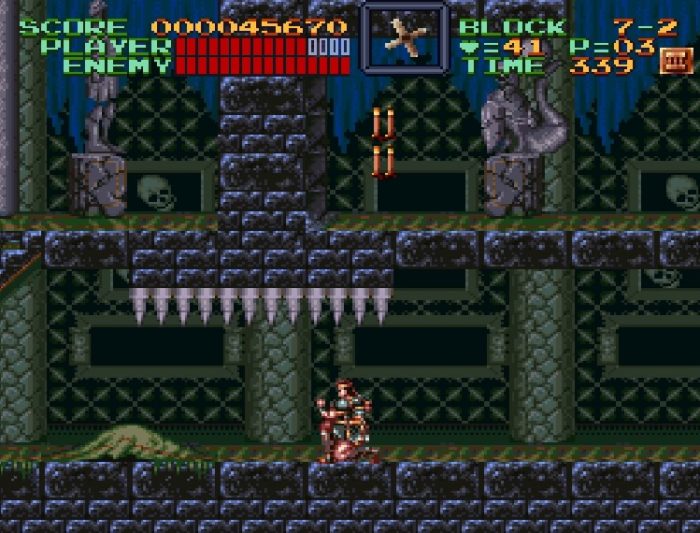
The gallery is a weird little level from beginning to end. Upon defeating the boss and grabbing the orb, the floor beneath you will begin to crumble, sending you down (based on the level map) to a much, much lower level. So yes, just like in the original game, when you are halfway through the castle, there is a part where you drop down to start the second half.
I mean…the calves this guy must have.
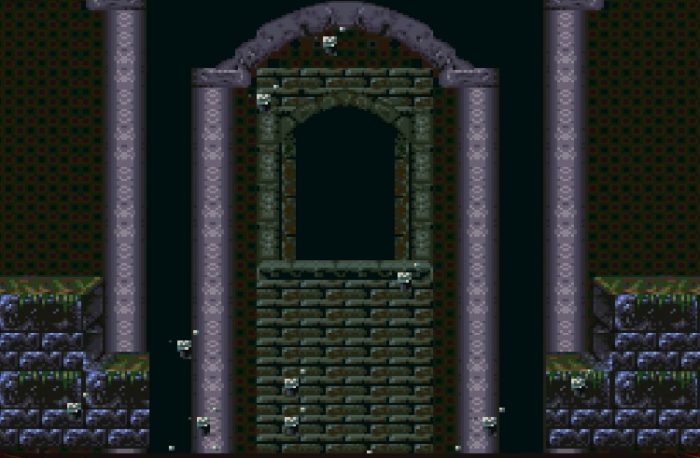
THE ONE WITH ALL THE TRAPS
This level seems innocuous and the spikes don’t seem all that dangerous, but they are. You’ll see one coming and you’ll think you’ve got it figured out and suddenly you’re splayed out and stone cold.

OK, so I will admit that this game has a lot of Wall Meat. I can see Chicken-A-Blocks only so many times before it kind of gets old. You can mess up and still bounce back pretty easily.
They throw spikes and disappearing floors at you, both only briefly.
The level is capped off with a rematch with The Monster. See, they called him The Monster this time, and not Frankenstein, so I call him The Monster.
He is also painfully easy. Granted, I still rocked my triple Boomerang, but he really didn’t do much besides lurch. Not to mention he goes in without his hunchback sidekick like he had in the original game. The Monster without his little companion? This is truly the darkest and saddest timeline.

STAY GOLD, SIMON
The treasury is home to Dracula’s excessive wealth. Even the tattered drapes sparkle with diamond dust and chests overflow with jewels when you jump on them.
The only part of this level that I dislike is the part where bricks fall from the sky. As I’ve mentioned in previous articles, I loathe this random mechanic in games and hated it in Castlevania III. I suppose I could’ve waited until all the spikes were covered up before going forward but I got what the kids call “all antsy in the pantsy” and met my death hitting my head on a falling brick that slammed me into a bed of spikes. Life. Amirite?

The treasury has a variety of challenges, and all the candles and enemies reward you with money bags in one segment for all you high score junkies out there.

WHAT’S THE ROMAN NUMERAL FOR A?
The Map music on Stage A teases it, and when you being level A-1 that is indeed the song Bloody Tears from Castlevania II: Simon’s Quest, and as I’ve said before, it’s great. I loved it so much I looked it up online and listened to it a few times. Maybe more.
I’ve also said in previous articles in this series that the levels featuring Medusa Heads and rotating gears are my least favorite levels, but this one isn’t that bad. I suppose that probably means this level isn’t all that difficult.
I have managed to hang on to the boomerang (it’s kind of my thing) and it has made portions of this game easier than if I didn’t have it, but I still contend this isn’t an easy game – despite me running out of levels and examples to prove it.

THE FINAL STAGE

The final stage of the game is basically a boss rush mode. You will fight Slogra, Gaibon, the Grim Reaper and Dracula.

Oh right, now I remember why I considered this game hard. Slogra and the Grim Reaper are difficult, with Slogra’s pattern being especially hard to learn. Even when I did learn these bosses moves my reflexes were often not up to snuff. But still, I persisted and eventually I came out victorious.
Finally, we reach those beautiful stairs and we know what’s next, a face to face with Dracula.

As far as Dracula is concerned this is a sit down meeting, at least at first. Once he deigns to fight you, he does a medley of his previous tricks from part 1 and 3. He warps around the room and shoots fireballs (akin to the original), and then later creates firewalls (like in III).
The final battle, and he only has the one form, is not too difficult if you are familiar with the previous games. Even if you are, this battle is nowhere near as tough as the ones with Slogra and Grimace.
I won’t spoil too much of the ending, or how Dracula perishes in the end, but the ending and even the credits and music were satisfying.
JUST BECAUSE IT’S BETTER IS IT BETTER?
Enhanced graphics, a great soundtrack, better controls, unique levels and new physics, this Castlevania is better than the first three in every superficial way you can imagine, but does that make the overall experience better?
Personally, I’m not the type of person that feels the need to declare one thing better than another. It leads to unproductive debating when the simple, better reality is there’s a place in the world for both Castlevania and Super Castlevania IV. Besides, there’s a little game called Castlevania Chronicles that holds the true remake of the original game.
Super Castlevania IV is highly regarded as one of the best entries in the Castlevania series and for good reason. It’s the glossy blockbuster movie you’ll revisit from time to time because it’s fun to be in that world for a few hours. I played through it once to get my trophy and prove to myself that I’m not that soft a video game player. But I found myself constantly revisiting it long after the sound of the trophy ding faded. I should have been jumping ahead to the next game in the series but I didn’t. I stayed with Super Castlevania IV, because it was familiar, it was fun, and it was a great gaming memory that didn’t change revisiting it almost twenty years later.

So in the end, Dracula fell, Simon was triumphant, and the timeline doesn’t really matter (to me). I loved Super Castlevania IV as a kid and I still love it today, whether you consider it easy or tough as nails doesn’t really matter. When Castlevania does it’s thing and does it right, there’s nothing quite like it.
LEFTOVER HEARTS (NOW WITH MORE COLORS)
- Call Super Castlevania IV whatever you want, it’s a fun game to play and the graphics and music are fantastic. Is it easy? I beat it, so probably.
- I have no major issue with remakes and reboots unless they’re trying to remake a perfect movie like Robocop. Who thought we needed another Robocop? And a PG-13 one at that?! Sorry. I’m trying to keep my tangents relegated to the Leftover Hearts section.
The only remakes I don’t understand are those shot by shot remakes. Imitation is the highest form of flattery. Isn’t that what they always say? I suppose that makes Michael Haneke a tad bit egotistical for doing a shot by shot remake of his own film Funny Games (1997/2007). Get over yourself, Haneke!
This marks the last appearance of a Michael Haneke / Funny Games reference in this series of articles. You only had to endure three of them, and I got a few things off my chest, so it wasn’t that bad.
And for what it’s worth, you should see the original Funny Games once. Once. - If Dracula is back after a one hundred year hiatus, how exactly is a spry looking Simon Belmont called forth once again to defeat him? Do you see why defining this game is so dodgy?
- We should be thankful that the mid-level scenes merely showed you the map and not Simon by a fire practicing his saxophone. In the early 90s, most heroes in popular culture practiced their saxophones after a hard day of being super cool at whatever they did.
- Next time, we experience Castlevania: Bloodlines, a game I’ve never played until now. Will the experience be different without my now customary nostalgia goggles?

